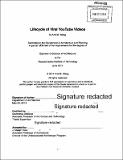Lifecycle of viral YouTube videos
Author(s)
Wang, Ami M
DownloadFull printable version (3.193Mb)
Alternative title
Lifecycle of viral You Tube videos
Other Contributors
Massachusetts Institute of Technology. Department of Architecture.
Advisor
Gediminas Urbonas.
Terms of use
Metadata
Show full item recordAbstract
YouTube was founded in 2005 as a video-sharing website. Today, it's a powerhouse social media platform where users can upload, view, comment, and share content. For many, it's the first site visited when looking for songs, music videos, TV shows, or just general entertainment. Along with the sharing potential provided by social media like Twitter, Facebook, Tumblr, and more, YouTube videos have the potential to spread like wildfire. A term that has been coined to describe such videos is "viral videos." This comes from the scientific definition of viral, which involves the contagious nature of the spread of a virus. Virality on the Internet is not a new concept. Back when email was the hottest new technology, chain e-mails spreading hoaxes and scams were widely shared by emailing back and forth. As the Internet aged, however, new forms of virality have evolved. This thesis looks at a series of 20 viral videos as case studies and analyzes their growth over time via the Lifecycle Theory. By analyzing viral videos in this manner, it aids in a deeper understanding of the human consciousness's affinity for content, the sociology of online sharing, and the context of today's media culture. This thesis proposes that the phenomenon of virality supports the claim of Internet as heterotopia.
Description
Thesis: S.B., Massachusetts Institute of Technology, Department of Architecture, 2014. Cataloged from PDF version of thesis. Includes bibliographical references (page 28).
Date issued
2014Department
Massachusetts Institute of Technology. Department of ArchitecturePublisher
Massachusetts Institute of Technology
Keywords
Architecture.